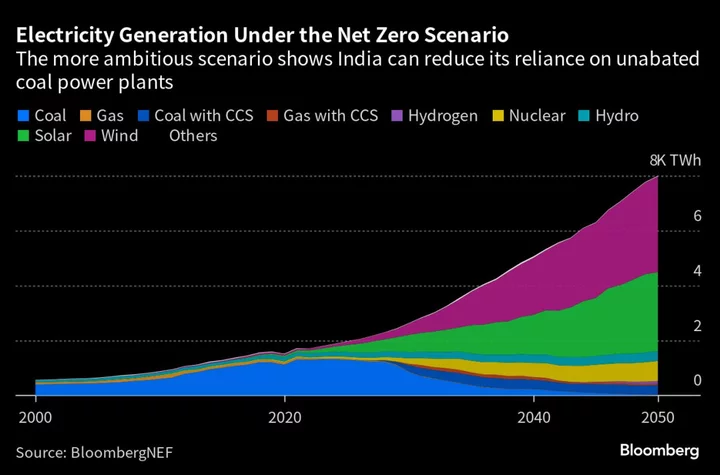India will need to invest $12.7 trillion in its energy system, or more than three times its gross domestic product, to reach net zero emissions by mid-century and help the world avert disastrous planetary warming, according to BloombergNEF.
Hitting that target early — ahead of India’s official goal of 2070, which lags the world’s largest economies — will require moving swiftly to clean-up the country’s vast and coal-dependent electricity sector, according to BNEF’s New Energy Outlook for India, published on Thursday.
That means grid investments to handle variable renewable power, and also scaling up the cash going into green energy.
The world’s third-biggest emitter of greenhouse gases currently produces about 70% of its electricity from coal, and the same fossil fuel underpins a range of heavy industries, such as steel, cement and aluminum. That’s despite rapid expansion in renewable energy, with a record-high of 16 gigawatts of utility-scale solar installed in 2022.
Vast funding is required to change that dynamic, and to cope with growing demand simultaneously. Hitting the 2050 spending target in line with global climate goals means $438 billion of investment every year until the deadline, according to BNEF data, a massive jump for a country that invested $17 billion in energy transition technologies last year.
Cumulative investments to expand power generation capacity alone will have to reach $2.8 trillion by 2050 — $2.7 trillion of that would be low-carbon, or more than $90 billion a year.
“Building all the necessary infrastructure would require investments at an unprecedented scale and speed, which the Indian banks alone may not be able to meet,” said Shantanu Jaiswal, head of India research at BNEF.
Global capital has been cautious. Eight of the global top 10 pension and sovereign wealth funds are yet to invest in India’s renewable-energy sector, according to BNEF, while India’s own pension and life insurance funds face restrictions.
India has raised the question of global capital repeatedly, but has been hampered by inefficiencies in its power market and, more recently, by the indirect impact of the US Inflation Reduction Act and European moves to woo clean-power investors.
“India needs to set sector-specific decarbonization pathways and to develop enabling policies to tap all sources of global and domestic financing,” BNEF’s Jaiswal said.
Under BNEF’s ambitious 2050 scenario, power-related emissions in the country would peak in 2024. Transport sector emissions would top out in 2028 with a rapid deployment of electric vehicles, while industrial emissions are seen reaching a maximum in 2031 followed by a sharp decline. Technology will play a role, whether that’s green hydrogen in steel or carbon capture, which could alone reduce 56% of emissions from cement manufacturing, according to BNEF.
For road transport, electrification will require both charging infrastructure and clean, affordable power to feed increased demand. Under BNEF’s net zero scenario, the impact on demand means India could end fossil fuel imports by 2050, almost fulfilling Prime Minister Narendra Modi’s goal of becoming self-reliant in energy by 2047, the year marking a century since independence.
Under a less ambitious scenario, a baseline assessment of how the energy sector might evolve as a result of technology changes driven by cost and not policy, India’s power mix still improves, though spending is more modest at $262 billion a year on average. In that scenario, rather than reaching net zero by 2050, India’s energy-related emissions rise by more than a fifth from 2021 levels, with the power sector, a key contributor, not peaking until 2036.
The only lower-middle-income nation among the very largest emitters, India aims to reduce the emissions intensity of its GDP by 45% from 2005 levels by 2030, and to have half of its power generation capacity run on clean sources — solar, wind, nuclear and hydropower — by the end of this decade.

